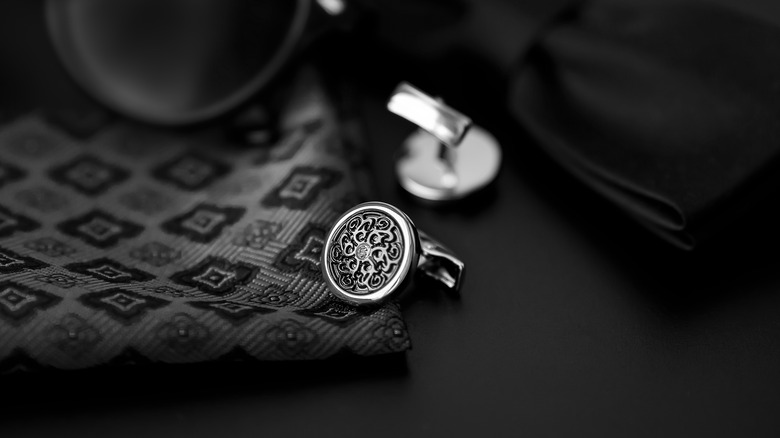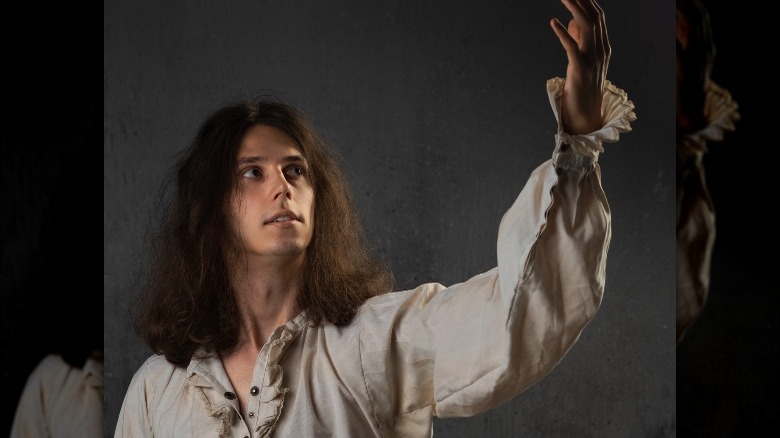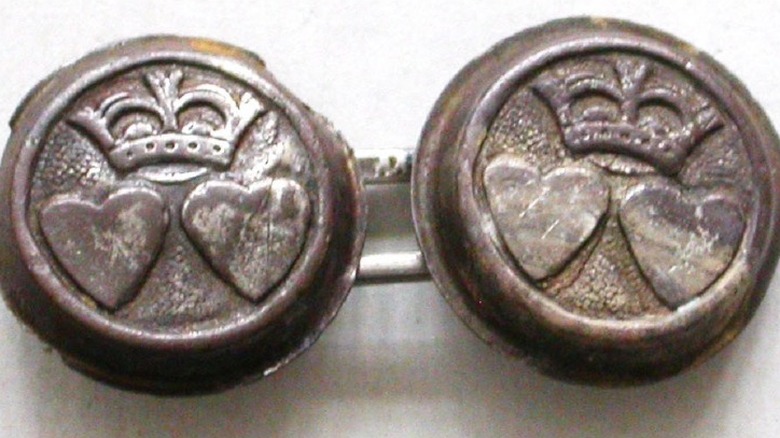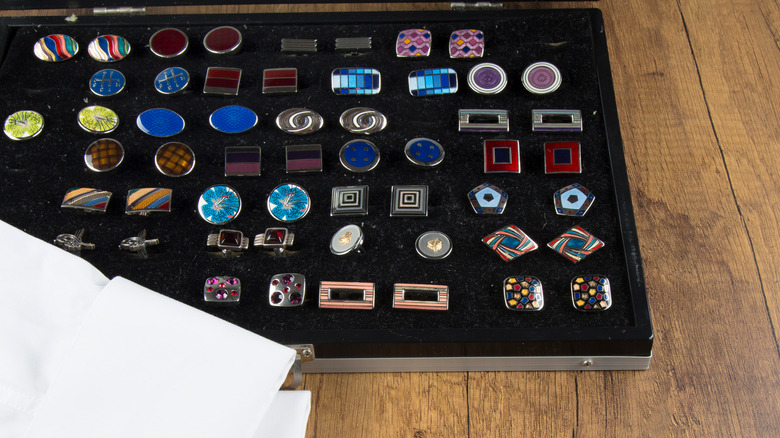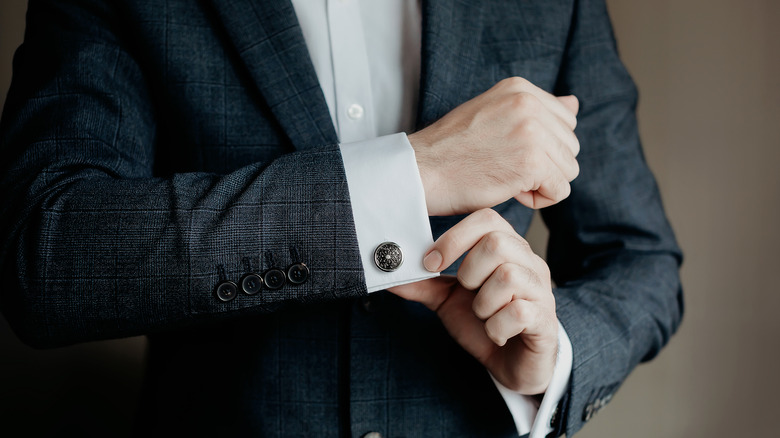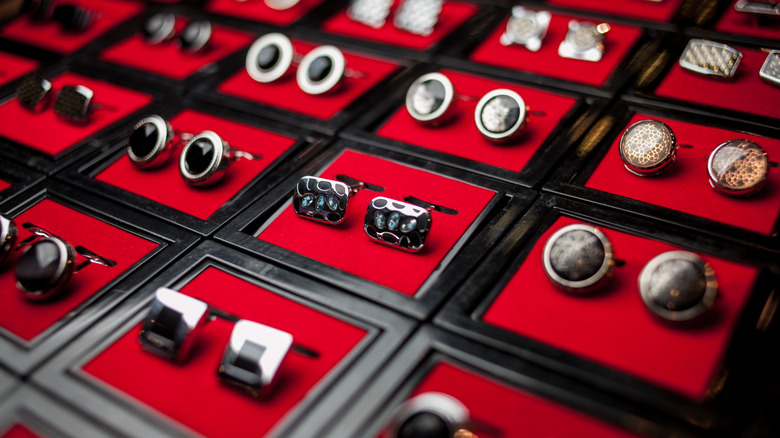The Historical Reason Cufflinks Were Invented
There are many accessories that can spruce up an outfit, and a pair of cufflinks is one of them. Its primary purpose is to secure cuffs, but it also gives a personal touch to an otherwise plain outfit. Today, most opt to wear cufflinks during formal events or business functions, but a pair can be worn with just about any shirt with cuff holes. As Pause reported, the use of cufflinks has evolved over the years, and they have become statement accessories that can express one's style preference.
There is a wide selection of cufflinks available on the market today — from classic to quirky — that can fit anyone's style. And there are others who own hundreds of cufflinks just so they can wear a pair that goes perfectly well with any color or style of outfit. Cufflinks are timeless pieces that have been around for centuries, and there's a practical reason why they were invented.
The evolution of clothing
In prehistoric times, humans used animal hides and items available in nature to improvise clothes. The clothes were mostly done in a simple tunic style that served its purpose (via History of Clothing). As time passed, the types of clothing and fasteners used to secure them evolved.
In the 1200s, strings, cords, and pins were used to fasten clothing. More fitting garments were made available, and they were often secured closer to the body with the said materials. During the Renaissance, one of the most popular types of clothing for noblemen was the long-sleeved top with ruffled cuffs. The cuffs were held in place by ribbons and ties, and eventually, sleeve buttons with jewels replaced them, according to Numis Cufflinks. The buttons were made from expensive materials, and some even had tiny paintings encased in quartz or glass. With the high costs of materials used, the buttons were mostly worn by the elite class.
Cufflinks in the 17th century and beyond
Little by little, the jeweled buttons were replaced by the earliest known form of cufflinks. In the 17th century, fashion-forward individuals and nobles started using a pair of buttons linked together with a small chain. It was during that period when stitched buttonholes appeared in clothing as well. The cufflinks were necessary to fasten cuffs, but the ornate designs made them interesting and fashionable accessories too, per Brand Depot. Most were made of gold and silver, and some were adorned with precious gems.
It was King Charles II — who was known for his fashion sense — who popularized cufflinks by wearing them often in public. Not only were cufflinks used in fashion, but they were also commonly given as gifts for special occasions as well, especially among the elites and royals. Cufflinks came with engravings, such as initials, crests, patterns, and fancy designs that made them unique.
The industrial revolution made cufflinks accessible
During the Industrial Revolution, the use of machines made manufacturing products easier. This made cufflinks available to everyone and not just the elite. According to Friar House, it was during this period, and after, that cufflinks became even more popular than ever. They were made in different materials, colors, and designs. A jeweler named George Krementz was inspired by a machine for making bullets and applied its concept to create a machine for mass manufacturing cufflinks (via Brand Depot).
Instead of expensive metals and crystals, cheaper versions of cufflinks were made of rhinestones and fake crystals. Zinc and copper were used as substitutes for gold, and the mineral marcasite was used instead of silver, per Numis Cufflinks. Cufflinks became even more popular when the double cuff or French cuff became a common part of menswear fashion. The cuffs were typically stiff with starch, which made using buttons difficult. Cufflinks were the easier alternative to fasten cuffs in place. As time passed and fashion changed, cufflinks also became a common accessory for women.
Cufflinks through the years
It was during the early 20th century when the use of cufflinks peaked. Luxury jewelry brands, such as Cartier and Tiffany's, released their own line of cufflinks, as reported by Brand Depot. By the end of the 20th century, however, there was a decline in the need for cufflinks, as clothing manufacturers started producing shorts that already came with buttons sewn on the cuffs.
The French cuff came back in fashion once again in the '90s, which brought a renewed interest in cufflinks, though most wear it during more formal occasions. In a book written by Marilyn Nissenson and Susan Jonas in 1991 aptly titled "Cuff Links," the authors went through the history of the accessory, and they came to the conclusion that the evolution of cufflinks was heavily dependent on fashion, particularly shirts (per the New York Times). It was born out of necessity, but it was also a way to express individuality. "In their own small way, they're a piece of social and sartorial history. And men don't have a lot of other options to express their personal taste," Nissenson said.
The biggest cufflink collection
Today, cufflinks come in different styles, designs, and colors that can match just about any outfit. Although these accessories aren't as popular as they used to be, there are some who collect cufflinks as a hobby. In 2020, a man named Carl Moulton from Canada was named the Guinness World Record holder for having the biggest collection of cufflinks. As of September 12, 2020, Moulton had 1,925 pairs of cufflinks in his collection.
Moulton started his collection when he changed his wardrobe and bought shirts with dual cuffs. He bought cufflinks to secure the cuffs, and people started noticing them. Since then, his friends and family started giving him cufflinks as gifts, which grew his collection steadily in the course of seven years. "It's unique cufflinks so there are no two pair the same," he told CHVN Radio. After getting recognition from Guinness World Records, Moulton purchased someone else's collection that added another 550 pairs to his own. "Now that I got the certificate, I'm done," he stated.
